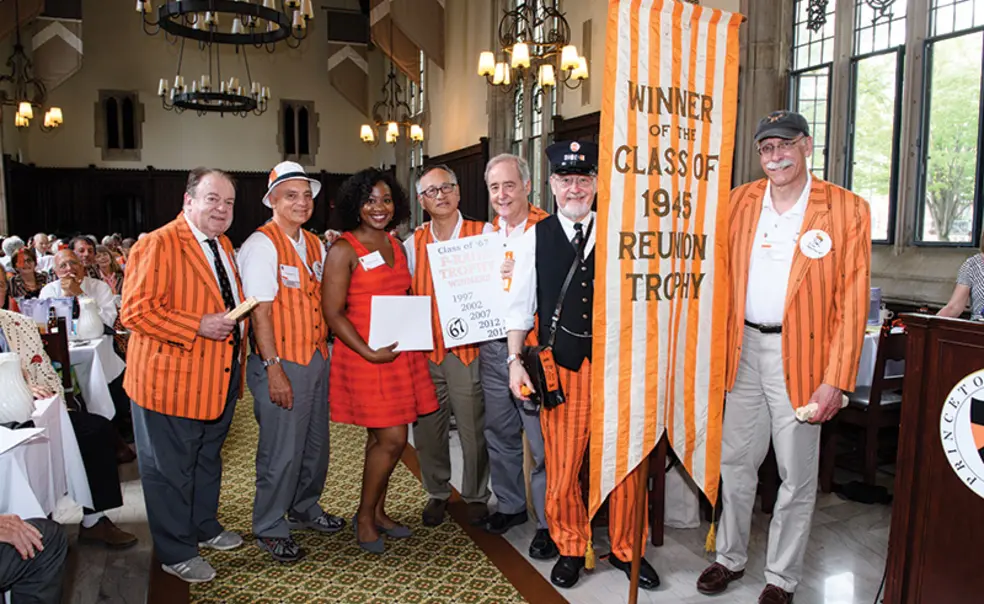Little Is Known About Mysterious Class of 1945 P-Rade Trophy
‘Nobody seems to know the actual originators of the trophy — who donated it, who thought it up’
It’s eight feet tall. It’s called a trophy, but it’s actually an orange-and-white banner hung on a crossbar. It has been carried in the P-rade every year for more than six decades by the class with the “most enterprising entry,” though exactly what that means is a bit murky.
The Class of 1945 P-rade Trophy is one of Princeton’s many quirky traditions, and a hidden gem, since many reuners don’t know about it. “This giant banner comes by, and most spectators don’t know what it is,” says Tom Tulenko ’67, a retired intelligence analyst and historian who has been P-rade chairman for his class since its 15th reunion and is a bit of an expert on the P-rade. “It’s a Roman-style trophy — not a cup, not a plate. It’s a banner on a big pole with a finial on top, the type that used to be carried in Roman triumphal parades. It’s actually the original definition of trophy.”
The trophy has been awarded since 1958, but many details about its origins have been lost, such as exactly what criteria were intended to be used to select the winner. “The word ‘enterprising’ is felicitously charming and flexible,” Tulenko says.
In recent years, seven judges have used a 10-point scale to rate each major Reunions class (except for the Class of 1945, which is not eligible) on 11 criteria, including class theme, costumes, floats, signs, and marching.
The Class of 1967 has won a record-breaking six times, while two classes have won the trophy five times: 1946 and 1955.
The winning class is decided a week or two after Reunions and announced — via email to the class president — in the winter. Representatives of the winning class are presented with the trophy the following spring at the annual Alumni Council awards luncheon, held the day before the P-rade, so the honor always goes to an off-year class. That class then carries the trophy in the P-rade. On the big day, an undergraduate is assigned to help carry the trophy in front of the class, ahead of the class banner. At the P-rade’s conclusion, the trophy is returned to Maclean House, where it stays until the following year.
“It’s only on view two days a year,” Tulenko says. This year, the banner will be carried by the Class of 1967.
Tulenko has scoured Princeton’s Mudd Manuscript Library for more information about the trophy, but, so far, has not found much. “Nobody seems to know the actual originators of the trophy — who donated it, who thought it up,” says Tulenko, who enjoys researching Princeton traditions.
“There are three sticks in the P-rade — the Gorman Mace, carried by the grand marshal; the Class of 1923 cane, carried by the oldest alumnus in the P-rade; and this trophy. This one is the most obscure.”
Tales of P-rades Past
Tom Tulenko ’67 will present a talk called “Tales of P-rades Past: Marching to Prospect Street, 1897-1992” at 1:30 p.m. on Friday, May 26, in East Pyne 010. The talk will explore the P-rade’s origins as well as the roots of many P-rade traditions.
“The P-rade was not always the vast, often ambling trek we know now,” Tulenko says. For 90 years, alumni classes marched eastward to the 1879 Arch and down Prospect Street before entering the University Field stadium, now long demolished, for a procession before a baseball game against Yale.
The photo-filled presentation will explore features of early P-rades that have vanished, including snake dancing and stunts, as well as the raucous origins of customs that have lasted.













No responses yet